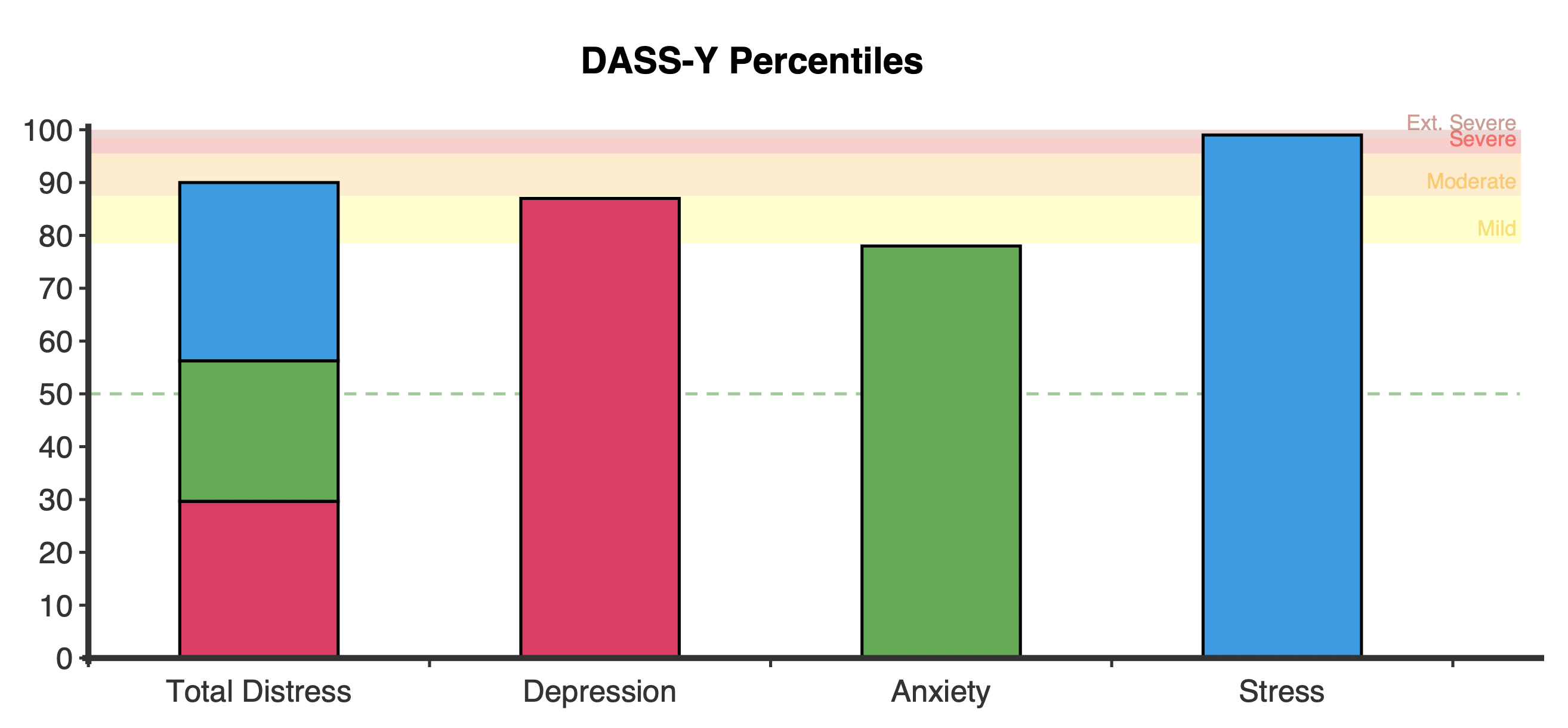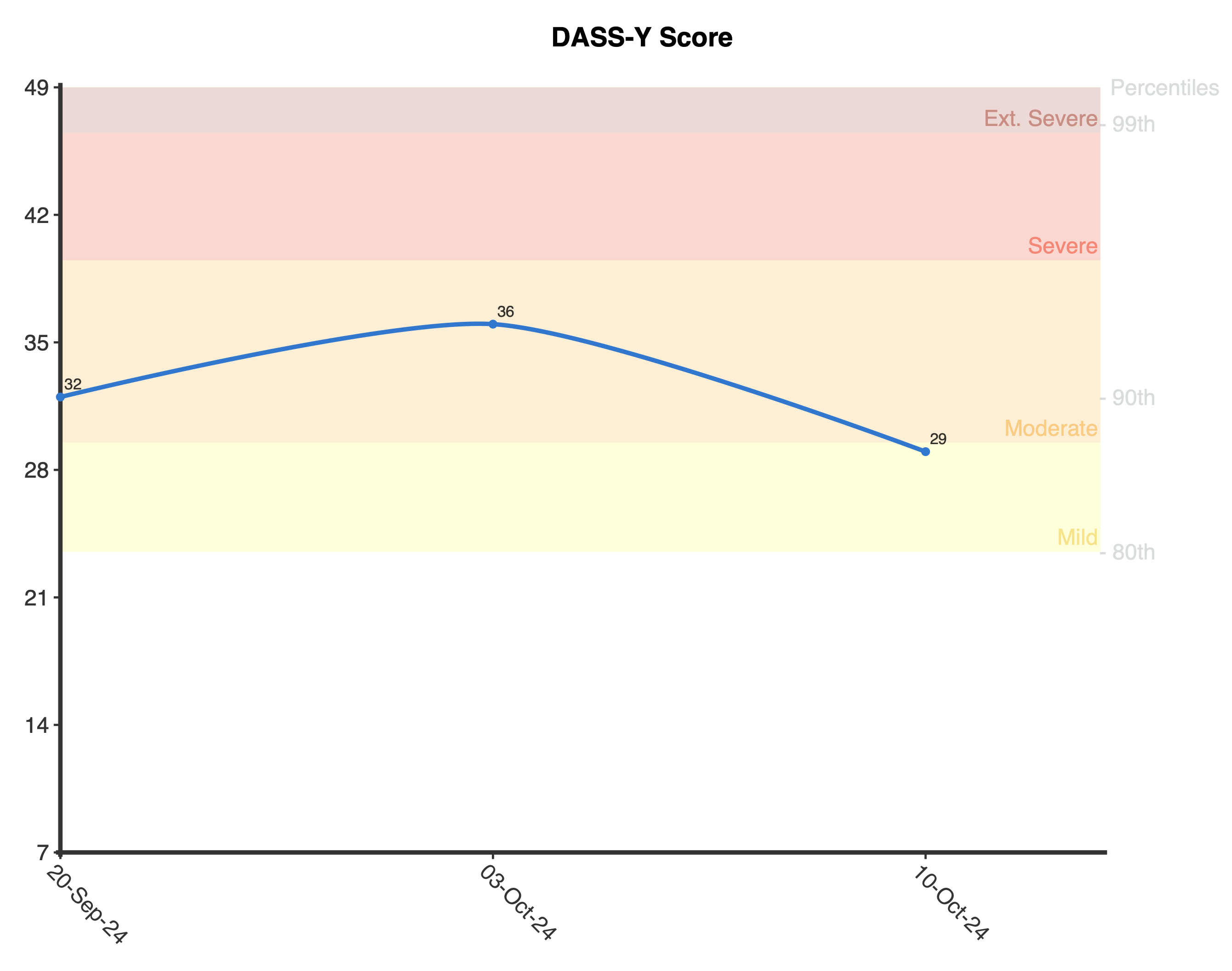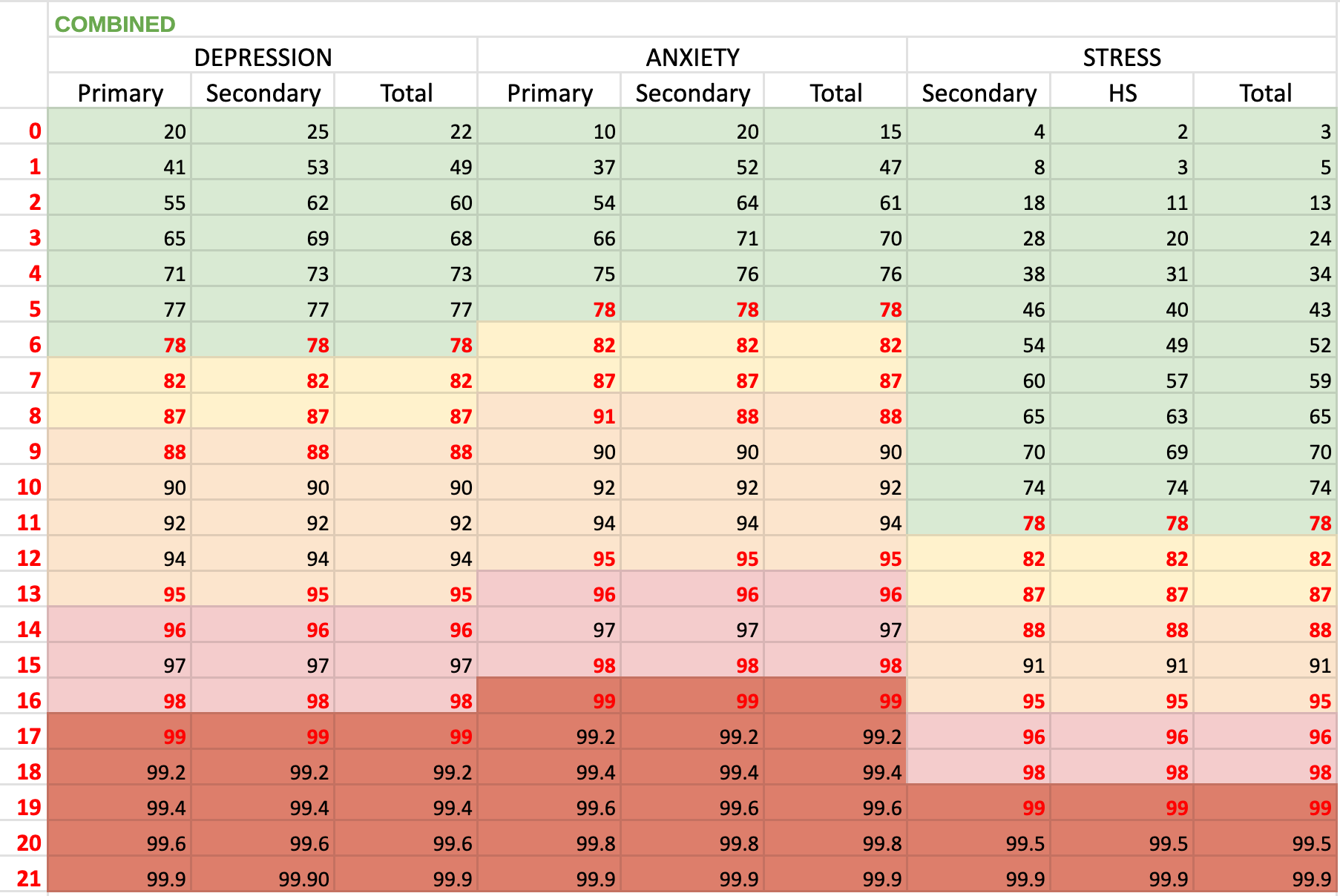The Depression Anxiety Stress Scales – Youth version (DASS-Y) is a version of the DASS-21 for youth aged 7 – 18 years of age designed to measure general psychological distress and the negative emotional states of depression, anxiety and stress. The wording and focus of the questions is simplified compared to other versions of the DASS, making it more relevant for young people.
While the three symptom clusters measured by the DASS-Y (Szabo & Lovibond, 2022) share many characteristics with each other (i.e. general psychological distress), the DASS-Y emphasises the specific symptoms unique to each in order to better discriminate between depression, anxiety and stress, and thereby producing more independent subscales. Nonetheless, similar to the DASS-21, the total score on the DASS-Y also provides an overall measure of psychological distress (Jovanovic, 2024).
The DASS-Y is suitable for clinical settings to assess for symptoms of psychological distress and to monitor the course of those systems over time. In non-clinical settings the DASS-Y is useful as a mental health screening questionnaire. The DASS-Y is based on a dimensional rather than a categorical conception of psychological problems, and scores emphasise the degree to which someone is experiencing symptoms rather than having diagnostic cutoff points. It is a useful tool for routine outcome monitoring and can be used to assess the level of treatment response.
Scores are presented as a total score (between 0 and 63) and a score for the three subscales (between 0 and 21). In addition, percentiles are computed comparing results to age and gender related peers (Szabo & Lovibond, 2022).

Percentiles help contextualise scores in relation to age and gender relevant sample, whereby a percentile of 50 indicates the respondent scored at an average (and healthy) level compared to typical peers (shown by a dotted line on the graph). Higher percentiles indicate more symptoms, with a percentile above 90, for example, indicating clinically significant psychological distress with more reported symptoms than 90 percent of peers.

Each of the three DASS-Y scales contains 7 items:

The primary difference between the stress and anxiety subscales lies in anxiety’s focus on acute responses and stress’s focus on chronic tension. Anxiety is more about the immediate, physiological response to perceived threats, involving fear and the body’s fight-or-flight reaction. Stress, on the other hand, encompasses a broader, more sustained response to ongoing demands that exceed an individual’s resources and coping mechanisms, leading to difficulties relaxing. The Anxiety subscale of the DASS-Y, therefore, should not be used as an indication of Generalised Anxiety Disorder, which is actually more in line with the Stress scale.

A graph is produced on first administration showing percentiles compared to age related peers. When the DASS-Y is administered on two or more occasions the graph demonstrates the change in symptoms over time. Given the dimensional nature of psychological distress it is useful to consider even small changes in symptoms over time.
The DASS-Y was developed using a large sample of responses from 2,121 Australian students aged 7-18 (61% female). Confirmatory Factor Analysis was performed on a calibration group (half the sample) to test the 3-factor DASS model on 40 items previously developed in exploratory studies. The best-performing 21 items based on both statistical and theoretical considerations were then selected, guided by the structure and item content of the adult DASS. Responses were then cross-validated in the second half of the sample. Results indicated good fit for the final 21-item 3-factor DASS model in both groups of children and adolescents (Szabo & Lovibond, 2022). A more recent factor analysis using both the original validation sample and a Serbian sample found that a bifactor model, represented by an overall general psychological distress factor and the three subscales, was a better fit and was invariant across gender and the two countries (Jovanovic, 2024).
Multiple regression analyses showed that when scores on the other DASS-Y scales were held constant, the Depression scale had a strong negative relationship with positive affect and life satisfaction, the Anxiety scale was strongly associated with physiological hyperarousal, and the Stress scale was associated with excessive worrying. However, the relationship between Stress and worrying was only evident from age 10 onwards (Szabo & Lovibond, 2022).
To assess the typical pattern of responding among young people, data was collected from a sample of primary school (aged 7 to 12, n=826) and high school (aged 13 to 18, n=1288) students, with the means and standard deviations split by age and gender and reported by Szabo and Lovibond (2022). Of note, significant gender differences were found in high school age students, whereby males reported lower overall scores, particularly on the stress subscale. The authors note that “due to systematic differences between the school groups, such differences need to be interpreted with caution.”
Means and standard deviations were the only metric available and the data was non-normal and positively skewed (Szabo & Lovibond, 2022). This data was was used to mathematically model percentiles by NovoPsych using a log-normal approach to model a skewed distribution. The severity descriptor scores and their corresponding percentiles were used as anchors (see Table 9 in Lovibond & Lovibond, 1995) to aid the modelling process. A skewed median was estimated in the first instance and alongside the percentile anchors, the log-normal distribution was used to fill in the gaps. The total score percentile was approximated using a similar approach where the mean and standard deviation could be estimated from the subscales. This percentile approximation process was completed for each age-group and for each of the possible genders (male, female, or combined).
Reliable change scores have been determined by NovoPsych from data collected between December 2022 and September 2024 where clients had completed multiple DASS-Y assessments. Firstly, ‘normal’ severity data was excluded to ensure that analysis was only conducted on individual’s presenting with clinically significant distress. The resultant sample sizes were 3,093 for the total score, 2,745 for the depression subscale, 3,155 for the anxiety subscale, and 2,982 for the stress subscale. To allow for practitioners to monitor change within the subscales and for overall general psychological distress, four reliable change scores were calculated. Reliable change scores were calculated using the Jacobson-Truax method of clinical significance classification (Jacobson & Truax, 1991) using calculated Cronbach alpha’s from the NovoPsych data. The internal reliabilities used were 0.94 (overall score), 0.93 (depression), 0.87 (anxiety), and 0.87 (stress). The reliable change score for the depression and anxiety subscales was 4, for the stress subscales was 3, and the reliable change score for overall psychological distress was 7.
The percentiles were mathematically modelled by NovoPsych using a log-normal approach to model a skewed distribution. The severity descriptor scores and their corresponding percentiles were used as anchors (see Table 9 in Lovibond & Lovibond, 1995) to aid the modelling process. The percentile approximation is presented below by gender (for the subscales) and for the Total Score.

Figure 1. Subscale percentiles for males.

Figure 2. Subscale percentiles for females.

Figure 3. Subscale percentiles for combined genders.

Figure 4. Percentiles for Total Score.
Szabo, M., & Lovibond, P. F. (2022). Development and Psychometric Properties of the DASS-Youth (DASS-Y): An Extension of the Depression Anxiety Stress Scales (DASS) to Adolescents and Children. Frontiers in Psychology, 13, 766890. https://doi.org/10.3389/fpsyg.2022.766890
DASS-Y website: https://www2.psy.unsw.edu.au/dass/DASSY.htm
Jacobson, N., & Truax, P. (1991). Clinical significance: a statistical approach to defining meaningful change in psychotherapy research. Journal of Consulting and Clinical Psychology, 59(1), 12–19. https://doi.org/10.1037//0022-006X.59.1.12
Lovibond, S.H. & Lovibond, P.F. (1995). Manual for the Depression Anxiety Stress Scales (2nd ed.). Sydney: Psychology Foundation (Available from The Psychology Foundation, Room 1005 Mathews Building, University of New South Wales, NSW 2052, Australia. https://www2.psy.unsw.edu.au/groups/dass/
Szabo, M., & Lovibond, P. F. (2022). Development and Psychometric Properties of the DASS-Youth (DASS-Y): An Extension of the Depression Anxiety Stress Scales (DASS) to Adolescents and Children. Frontiers in Psychology, 13, 766890. https://doi.org/10.3389/fpsyg.2022.766890
NovoPsych’s mission is to help mental health services use psychometric science to improve client outcomes.
© 2023 Copyright – NovoPsych – All rights reserved